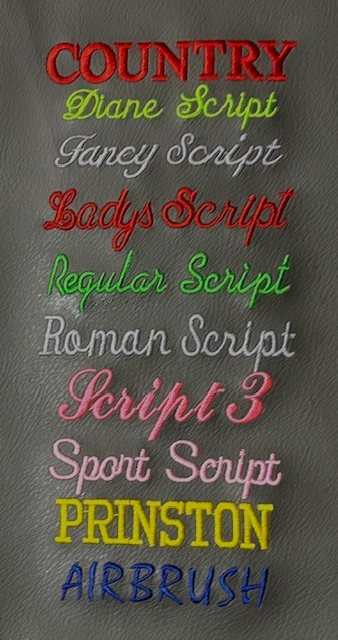The Art of Custom Needlework: Opening the Tricks to Creating One-of-a-kind and Remarkable Designs
Needlework, a craft soaked in tradition and creativity, holds within its complex stitches the power to change material right into a canvas of distinct expression. The keys to creating custom needlework styles that mesmerize the eye and leave a long lasting impression lie in a fragile equilibrium of method, creative thinking, and focus to information. As we explore the world of customized embroidery, we reveal the nuanced interplay in between string selection, stitch intricacy, and layout customization that boosts a simple garment to a job of art. Join us on a journey with the art of custom-made embroidery as we unwind the secrets behind crafting really unforgettable and distinctive creations.
Selecting the Right Needlework Threads
When choosing needlework strings, what essential aspects should you consider to make certain the ideal outcomes for your custom styles? The choice of embroidery thread is vital in establishing the last result of your embroidered design. One of the main factors to consider is the material of the string. Different materials such as cotton, polyester, rayon, and silk offer differing degrees of luster, sturdiness, and appearance. It is important to select a string material that matches the fabric you are stitching on and aligns with the wanted look of the layout.
Furthermore, the weight or density of the thread plays a considerable role in the look of the embroidery. Thicker strings can add measurement and texture to your style, while finer strings are suitable for detailed details and little message. In addition, thinking about the color fastness and washability of the string is essential to guarantee that your custom layouts maintain their top quality and vibrancy with time. By very carefully examining these variables and choosing high-quality strings that fulfill your details needs, you can boost the visual allure and longevity of your stitched developments.
Exploring Different Stitch Strategies
To explore the realm of 'Discovering Different Stitch Methods', one must realize the details and subtleties that each sewing technique brings to the art of needlework. Different stitch strategies not only add aesthetic passion yet also add to the overall structure and dimension of the design. One popular stitch method is the satin stitch, which involves closely stuffed parallel stitches to develop a smooth and glossy surface area, suitable for completing shapes and developing bold lays out.
On the various other hand, the backstitch is a flexible method usually used for describing and including great details. It entails stitching backward to create a solid line of embroidery. Furthermore, the French knot stitch includes a tactile element to styles, excellent for producing distinctive accents like blossom centers or decorative touches.
Exploring various stitch techniques allows embroiderers to play with light, shadow, and depth within their designs, raising the visual charm and imaginative high quality of their needlework tasks. By grasping various sewing methods, one can unlock limitless opportunities for creating distinct and unforgettable custom embroidery pieces.
Incorporating Personalized Design Elements
Having explored the intricacies of different stitch techniques such as the satin stitch, browse around these guys backstitch, and French knot, the focus currently changes in the direction of including tailored layout elements in personalized needlework projects. Personalized style aspects play Clicking Here an important function in making needlework jobs absolutely distinct and remarkable.
One more way to integrate individualized design elements is by including signs or themes that hold special definition to the recipient or reflect their passions and individuality. For example, including a favorite blossom, pet, or hobby-related symbol can make the needlework layout a lot more purposeful and individualized. Furthermore, selecting shades that reverberate with the recipient or straighten with the intended motif can additionally boost the customization of the needlework job.
Understanding the Art of Shade Coordination

One key aspect of color coordination is recognizing color theory. This includes recognizing just how different shades engage with each various other, the emotions they share, and how they can be combined to create aesthetically enticing designs. By using color concept concepts, embroiderers can produce unified shade combinations that enhance the general appearance of the layout.
Furthermore, taking note of comparison is vital in shade coordination. Using contrasting shades can assist certain components of the layout pop, boost clarity, and create an aesthetically vibrant embroidery piece. By understanding the art of shade sychronisation, embroiderers can raise their designs and create unforgettable items that resonate with customers and customers alike.
Enhancing Structure With Advanced Needlework Stitches
French knots, as an example, are perfect for adding small, increased dots to your design, resembling the appearance of grains or producing a textured surface. Bullion knots, on the other hand, can be used to produce twisted, ropelike components that include a lavish feel to the embroidery. Seed stitching entails little, scattered stitches that can fill in locations with a speckled structure, while turkey job produces fluffy, dimensional accents reminiscent of pet fur or foliage. Explore these sophisticated needlework stitches enables you to push the borders of standard needlework and produce genuinely special and aesthetically appealing appearances in your styles.
Conclusion
In conclusion, the art of custom embroidery includes a mix of picking the ideal strings, discovering various stitch methods, including tailored style components, mastering shade sychronisation, and enhancing structure with sophisticated stitches. By recognizing and implementing these key elements, embroiderers can develop distinct and unforgettable designs that display their creativity and skill. Needlework lovers can unlock the secrets to developing stunning and custom items that stick out and leave a long-term perception.